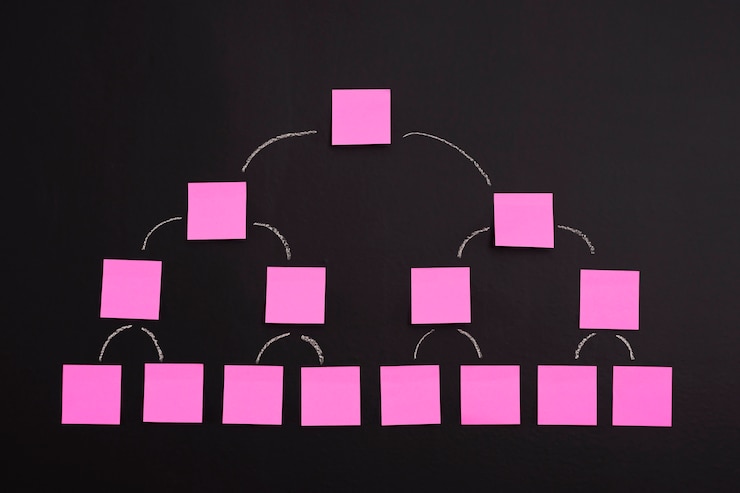In digital marketing agencies and small business administration, the organizational structure stands as a cornerstone of success. How your agency team is structured can profoundly influence its efficiency, productivity, and ultimately, its ability to scale. But navigating the myriad options can be daunting, and many digital marketing agencies and small business owners struggle with figuring out how to structure your marketing team.
Fear not, for we’re here to guide you through the maze of possibilities and help you figure out the most efficient digital marketing agency structure.
Understanding The Agency Team Structure
At its core, agency team structure refers to how roles, responsibilities, and reporting lines are organized within digital marketing agencies. It’s not just about who reports to whom, but also about how teams collaborate, communicate, and deliver results. Whether you’re a startup or a digital marketing recruitment agency looking to structure your team for growth or an established agency seeking to optimize your organizational framework, understanding the nuances of different structures is essential.
Importance of Organizational Structure of Digital Agency
The importance of getting the organizational structure of digital agency right cannot be overstated. A well-designed structure can foster a culture of collaboration, streamline workflows, and empower team members to perform at their best. Conversely, a poorly designed structure can lead to confusion, inefficiency, and missed opportunities.
The way your digital marketing agency is structured can make or break its success. Regardless of the type of agency you run, whether it’s a digital marketing agency or a small business administration firm, your team structure is pivotal in determining its effectiveness, efficiency, and overall performance.
Defining your agency team structure offers numerous benefits that contribute to the smooth functioning and growth of your organization:
Clear Roles and Responsibilities:
Having a defined team structure ensures that each team member understands their role and responsibilities clearly. This clarity prevents confusion, minimizes duplication of efforts, and enhances communication and collaboration. When everyone knows where they fit into the structure, productivity and ownership naturally increase.
Efficient Workflow and Resource Allocation:
A structured hierarchy enables efficient planning of workflows and allocation of resources. Project managers can assign tasks, distribute workloads, and coordinate seamlessly when the team structure is clear. This clarity allows for optimal resource utilization and ensures that tasks are assigned to the most suitable individuals.
Effective Decision-Making:
With defined roles and reporting lines, decision-making becomes faster and more effective. Team members are empowered to make decisions within their areas of responsibility, leading to quicker responses to client needs and project requirements.
Collaboration and Communication:
A clear team structure promotes effective collaboration and communication within the agency. Clear reporting lines and communication channels facilitate the flow of information between teams, departments, and stakeholders, improving coordination and teamwork.
Specialization and Expertise:
Organizing teams based on skill sets allows agencies to leverage the expertise of individual team members and departments. This specialization enables agencies to deliver high-quality services across different areas, ensuring that the right skills are matched with the right projects.
Scalability and Growth:
A scalable team structure is essential for long-term success. It enables agencies to expand their operations, add new team members, and diversify their service offerings without sacrificing efficiency or quality. A well-designed structure can adapt to increased project volumes, changing client demands, and market dynamics.
Career Progression and Talent Development:
A structured team provides opportunities for career progression and talent development within the agency. Clear growth paths and transparent hierarchies motivate team members to invest in their professional development, leading to higher employee retention rates and overall satisfaction.
Client Satisfaction:
A strategic team structure directly impacts client satisfaction, which in turn affects the agency’s bottom line. A well-structured organization ensures effective communication, timely project delivery, and meeting client expectations, ultimately enhancing client satisfaction and fostering long-term relationships.
How To Structure Your Marketing Team
In the following sections, we’ll explore five high-level options for digital marketing agency structure, ranging from the traditional to the innovative.

But before we dive into the specifics, let’s address some common questions and misconceptions about agency team structure. What factors should you consider when choosing a digital marketing agency structure? How does the size and nature of your agency impact your decision? And what are some best practices for designing and implementing an effective team structure? These are just a few of the questions we’ll explore in the coming sections.
Now, let’s explore the five options for agency team structures in more detail.
5 Most Effective Digital Marketing Agency Structures
When it comes to structuring your agency team, there’s no one-size-fits-all solution. The nature of your business, its goals, and its stage of development all play a crucial role in determining the most suitable organizational framework. In this comprehensive guide, we’ll explore five high-level options for agency team structures, each with its own unique advantages and challenges. Whether you’re a startup looking to lay the foundation for growth or an established agency seeking to optimize your operations, understanding these options is essential for success.
Flat Structure: Everyone in One Big “Room”
In a flat structure, everyone—or almost everyone—reports directly to the founder(s). This egalitarian approach is often characterized by minimal hierarchy and a collaborative working environment. Rather than distinct departments or layers of management, team members may wear multiple hats and work closely together on various tasks.
Pros:
Flexibility to tailor the structure to specific needs.
Ability to experiment with different approaches.
Adaptability to changing circumstances.
Cons:
Lack of standardization and consistency.
Challenges in recruitment and retention.
Potential for inefficiency and confusion.
Implementation:
Implementing an eclectic structure involves identifying the strengths and weaknesses of your current framework and making strategic adjustments to improve alignment with your agency’s goals. Conduct regular assessments to identify areas for improvement and experimentation. Leverage feedback from team members to finetune your approach and ensure continued adaptation to evolving business needs.
For agencies operating under an eclectic structure, transitioning to a more standardized approach may be necessary for long-term success. By carefully evaluating their organizational needs and adopting best practices from proven models, eclectic agencies can position themselves for growth and profitability.
Strategies for Implementing Organizational Structure of Digital Agency
Here are three essential strategies to enhance the growth potential of your agency’s team structure:
Continuous Role Evaluation and Alignment:
Regularly assess the roles and responsibilities within your agency’s team structure. Ensure that they align with your current growth strategy while allowing flexibility for future expansion. Identify any overlaps or gaps in responsibilities and make necessary adjustments to enhance efficiency and clarity.
By keeping roles well-defined and aligned with your agency’s goals, you can optimize performance and productivity.
Integration of Scalable Tools:
Invest in scalable project management software and resource management tools that can grow alongside your agency. Look for tools that support collaboration, communication, and efficient workflow management. It’s crucial to choose tools that resonate with your teams and streamline their processes effectively.
By integrating scalable tools, you empower your team to work more efficiently and adapt to the demands of a growing agency seamlessly.
Regular Review and Adaptation:
Frequently review your agency’s team structure, processes, and overall performance. Solicit feedback from team members, clients, and stakeholders to identify areas for improvement. Remain open to making necessary adjustments and adapting your team structure based on evolving business needs and market dynamics.
By embracing a culture of continuous improvement and adaptation, you position your agency for sustained growth and success.

Boosting Agency Growth Through Strategic Hiring
In the quest for business expansion, strategic hiring can be a game-changer. Digital marketing recruitment agencies like Bionic Talent offer a shortcut to accessing top talent. By tapping into their vast networks, agencies can swiftly find the right candidates. This streamlined process saves time and resources, allowing agency leaders to focus on business priorities.
If you’re an agency owner looking to strategically grow your business while maintaining a tight budget you’ve come to the right place! With Bionic Talent, you can save up to 80% in overhead costs. Interested in learning more? Schedule a meeting today!




